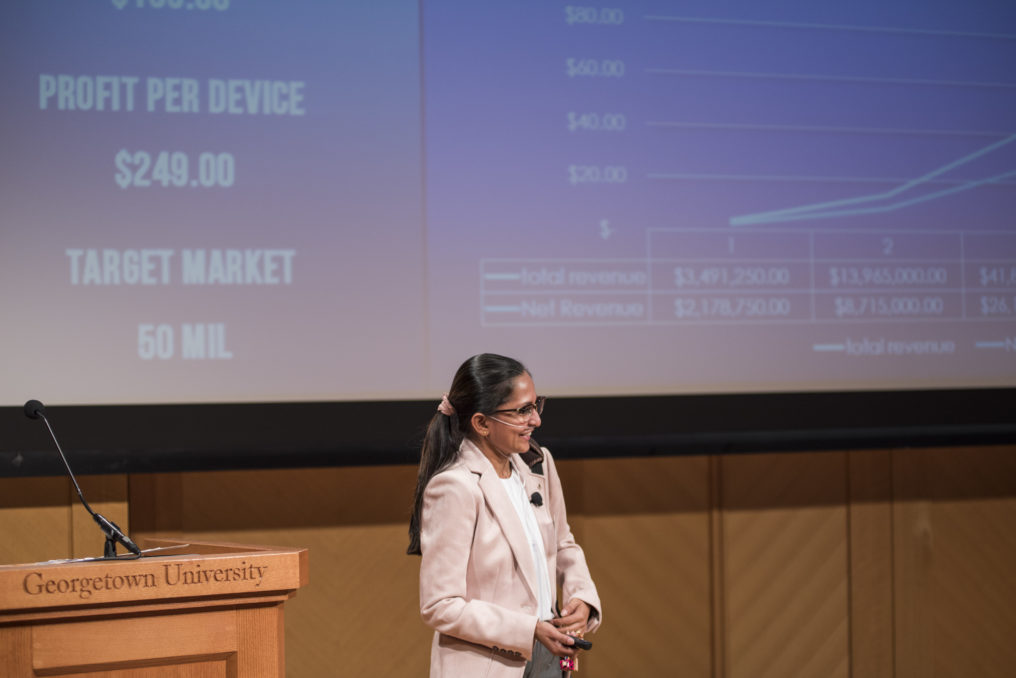A Georgetown University graduate student who suffers from life- threatening heart and lung damage took control of her own health in an innovative way.
Her name is Shavini Fernando and instead of letting her condition get the best of her, she created a wearable tech product to combat it.
Prior to attending Georgetown, Fernando earned a Bachelor of Computer Science from the University of Portsmouth in the UK and an International MBA from Edith Cowan University in Australia. She moved to the U.S. from her home in Sri Lanka in October 2015, around the same time she also found out about her heart condition called Eisenmenger’s Syndrome. The condition developed over time as an effect of high blood pressure in the lungs due to heart defects from birth.
Before she left Sri Lanka, Fernando’s doctors told her she had a hole in her heart and two years to live. “That was more like a challenge to me,” Fernando said after hearing this news. She was told that there was no treatment for her condition and she told her doctors, “I will be back in two years to say hi to you.” She came to the U.S. to get a second opinion from John Hopkins Hospital and was diagnosed with Eisenmenger’s Syndrome.
Fernando began taking medication since it would take up to two years to get a heart and lung transplant. After six weeks on the medication and at her first progress check, she could only walk 600 feet at a time without getting tired. After six months, her progress was up to 1,400 feet. Today, she can walk 1,980 feet. Fernando was also hooked up to an oxygen machine but after six months, she started pushing her boundaries, reducing use of oxygen.
It was when Fernando got bored at home that she decided to go back to school. She was accepted into Georgetown, John Hopkins and George Mason University, but she decided to attend Georgetown where she has been able to create her own curriculum. Fernando is in school to earn a Master of Arts in Communication, Culture and Technology with an emphasis on visual computing.
“I was so occupied, I had no time to think that I was sick,” she said of her studies.
Fernando said she was able to excel in the program and be able to live alone due to the support of her family and friends. Everything was going good, maybe even too good.
One random day, while Fernando was on campus, her heart stopped and she literally turned blue. She couldn’t breathe and she was hitting her chest.
“You call 911 and let me do what I do because I have three minutes to get my heart started again,” Fernando recalled telling her classmates who were nearby during the incident. “I managed to get the heart started again.” She said this has happened before but every time, she thought it was an asthma attack, not knowing her heart was stopping.
After this incident, Fernando began talking about OxiWear to her doctor and joking about making a tech to monitor her oxygen levels because it has continuously dropped after this happens.
“I was just joking, then he was like, do it. Do it before anyone else can do it,” she said.
Since she is a software engineer and technologist herself, she did it. Fernando started designing the OxiWear device under an independent study during spring 2018 where she finished the prototype and continued working on the patent during the fall of 2018. Fernando worked at building the werable device on her dining room table and after six prototypes, she was able to get it right.
“When it started working, I was like oh my gosh, I made it!” she said.
Fernando’s OxiWear device is an ear-wearable vital monitoring and emergency alert device that warns people when their vitals are out of normal range and contacts 911 to receive help. Each device is personalized via a mobile app paired with the product. Users can set lower and higher ranges depending on their needs.
Fernando went on to compete in Georgetown Entrepreneurship’s second annual Leonsis Family Entrepreneurship Prize “Bark Tank” pitch competition on Nov. 28, 2018, where she won a total of $35,000: $30,000 for first place and $5,000 for the people’s choice award for OxiWear, which was originally named O2Wear. Fernando said she is still working on the communication regulations but, currently, the device can monitor heart rates and oxygen levels.

Fernando also won $5, 000 at Georgetown’s School of Foreign Service’s Global Impact Pitch Competition on Nov. 18. Fernando said in a Medium article that she has also received grants to make a more smaller optimized version of the device, so it doesn’t look so much like medical equipment.
So what’s next for Fernando?
Due to her condition, Fernando cannot fly so she says she’s “stuck in D.C.,” but she’s glad because this is her “perfect place” because people like her “crazy ideas.” She is currently working as a web development consultant at Georgetown’s Graduate School of Arts and Sciences as she finalizes her OxiWear product.







